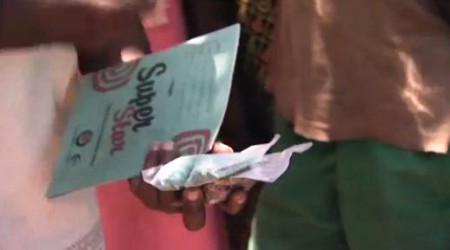- Seed savers: everyone’s got an angle, from Seeds of Hope and Change to Seed Bank Bingo.
- Italian lemons enjoying a renaissance. In California, natch.
- India registers Assam farmers’ traditional rice varieties. In other news, rice water “is also used as shampoo, according to community elders”.
- US$9 million to “implement and evaluate four approaches” to controlling Striga in Africa. One day we’ll know.
- Denver Botanic Gardens does amaranth.
- Evolution of bearded pigs. Good to know. Good to eat?
- Bioversity banana team guest blogs at Annals of Botany. But surely they have a blog of their own. No, wait…
- Agriculture is bad for your health.
Selling seed of orphan crops in Kenya
The latest episode of BBC’s Horizon programme deals with a number of things we’ve blogged about here before, for example soil mapping in Africa and biochar. But the payoff for us here is the last segment, which is on a Kenyan seed company called Leldet, which…
…now offers farmers the opportunity to buy different varieties of previously forgotten under-utilised seeds, more suitable for the area. They supply them in smaller quantities so farmers aren’t over reliant on one crop.

Watch it quick, because I don’t know how long it will stay on the site.
Nibbles: Food security, Food carts, Cotton, Ritual, C4 C3 CC, American Indian diets, Community genebanks in India, Fowler, Dark earth soil, Domestication
- German donor examines food and security, notes “the fast loss of biodiversity”.
- Food carts are successful oases in at least one food “desert”.
- Yesterday’s Botany Photo of the Day was American cotton.
- Good news, everyone: “Hardcore farmers prefer lowkey rituals.” Obviously the memo didn’t reach the children of the corn.
- Photosynthesis and climate change: it’s complicated.
- Native Americans try to reclaim control of their foodways. And their waists.
- “…every district should have a community-controlled seed centre with a gene bank for traditional seeds.” Of course it should. “The local available seed diversity needs to be protected and conserved at any cost.” Of course it must.
- “Right now, all over the world, projects are underway to store seeds…“
- Dark earths not just in Amazon, Africa too.
- Presentation on IFAD project on cultivating wild aromatic etc. species for money in Morocco.
Nibbles: ITPGRFA, Hotspots, Adaptation, Agrobiodiversity, Potatoes and climate change, Cowpeas and drought, Apios, Tree planting, Fairtrade, Egyptian archaeobotany, Bolivian video
- All about the International Treaty on PGRFA.
- More, much more, on that climate change hotspots study.
- IDRC on climate change adaptation in Africa. Almost nothing on agricultural diversity as a coping mechanism.
- Unlike this.
- Or this, for that matter. Never knew the Basque country was such a hotbed of potato research.
- Or…oh forget it.
- What, in the name of all that is happy, is hopniss?
- Danone buys some goodwill.
- Fairtrade chocolate: this looks like it should be really important. Is it?
- So, you say you want to know what plant remains were found in the baskets in Tutankhamun’s tomb?
- Bolivian agricultural biodiversity, anyone?
Brainfood: Baby’s veggies, Chickpea and drought, Vine cactus breeding, Paleolithic rabbits, California protected areas, Wild pigeonpea, Pecorino classification, Milk composition, Phenotyping, Wild peas
- Vegetables by Stealth: an exploratory study investigating the introduction of vegetables in the weaning period. Sneaking them into the diet is the most common strategy used by mothers to introduce their kids to vegetables. Reeeeeally?
- Assessment of Iranian chickpea (Cicer arietinum L.) germplasms for drought tolerance. Four out of 150 local landraces showed promise. It really is a numbers game, isn’t it?
- In situ induction of chromosome doubling in vine cacti (Cactaceae). Potentially valuable autopolyploids were produced. Not that it was easy or anything.
- Who brought in the rabbits? Taphonomical analysis of Mousterian and Solutrean leporid accumulations from Gruta Do Caldeirão (Tomar, Portugal). People did, that’s who, but only during the later Upper Paleolithic. Before that it was mainly owls.
- Protected areas in climate space: What will the future bring? Nothing good. Both novel and disappearing climates are over-represented in current protected areas, at least in California.
- Progress in the utilization of Cajanus platycarpus (Benth.) Maesen in pigeonpea improvement. Baby steps.
- Classification of pecorino cheeses using electronic nose combined with artificial neural network and comparison with GC-MS analysis of volatile compounds. Wait, there are different kinds of pecorino?
- The need for country specific composition data on milk. Well, you’ve got me convinced.
- Rate-distortion tradeoff to optimize high-throughput phenotyping systems. Application to X-ray images of seeds. So, let me get this straight, basically, gauging the optimal trade-off between speed and accuracy in high-throughput phenotyping systems depends on what you’re measuring? Who writes these grant applications?
- Experimental growing of wild pea in Israel and its bearing on Near Eastern plant domestication. First pea growers were either very patient or very quick workers.